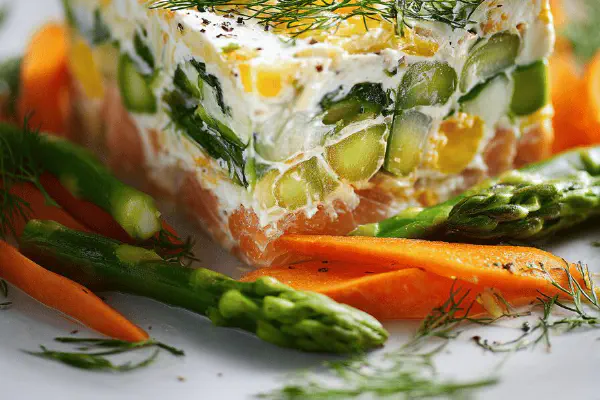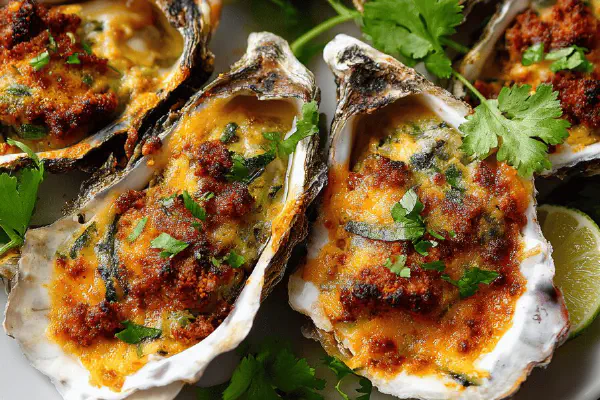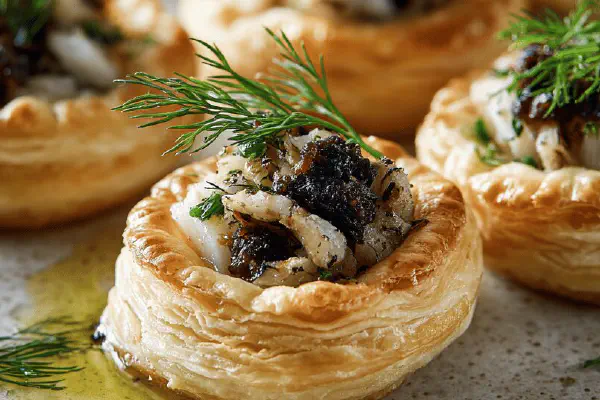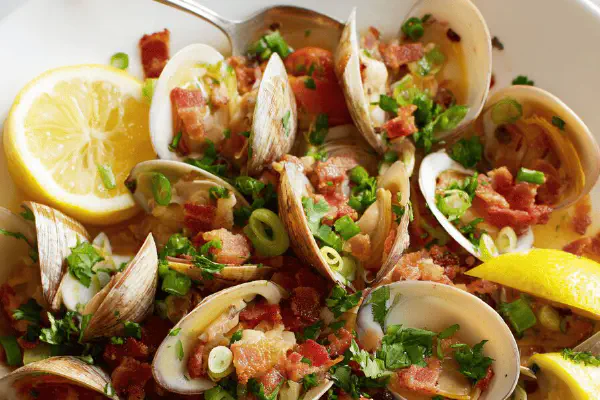Fish Terrine Twist

By Emma
Certified Culinary Professional
Ingredients
- 320 g fresh wild cod fillets cut into chunks
- 160 g fresh wild salmon fillets chopped roughly
- 4 large eggs
- 125 ml crème fraîche (thick, not whipping cream)
- 45 ml finely chopped fresh dill
- 1 lemon zest grated finely
- 3 fresh asparagus spears cooked until just tender
- 1 peeled carrot cooked, cut into sticks matching asparagus length
- 3 ml salt
- Freshly ground black pepper to taste
- Butter for greasing
- Parchment paper
About the ingredients
Method
- 1. Chill the fish pieces in freezer for 15-20 minutes until very cold but not frozen solid. This firms up fish and helps smoother puree, avoids warming in processor.
- 2. Preheat oven to 175°C (350°F). Prepare mold by lining a 22 x 12 cm loaf pan with buttered parchment leaving an overhang on two sides for easy lifting.
- 3. In a food processor pulse the cod and salmon together briefly until fine consistent texture but not turning to paste. Scrape sides down to avoid lumps.
- 4. Add eggs one by one, pulsing between additions. Pour in crème fraîche. Pulse 2-3 times to combine into thick batter - avoid over-processing or mixture becomes gluey.
- 5. Stir in dill and grated lemon zest with a spatula. Season with salt and pepper. Taste the mixture raw—should be fresh, herbal, slightly tangy.
- 6. Spread half the fish mixture evenly in the mold. Layer the asparagus and carrot sticks alternately on top in neat rows. Don’t crowd, just one layer.
- 7. Cover with remaining fish mix. Press gently with spatula to remove air pockets and level the surface.
- 8. Place the loaf pan in a larger baking dish. Pour hot water into the larger pan until it reaches halfway up the sides of the terrine mold—the bain-marie prevents drying and cracks.
- 9. Bake in center of oven for 25-30 minutes. Look for the terrine edges to firm up and center just set but still tender. A knife inserted should come out mostly clean but moist. Avoid overcooking or it crumbles.
- 10. Remove from oven and let cool in water bath 10 min, then lift from bath and cool to room temperature. Cover and chill minimum 4 hours, preferably overnight to develop firm texture.
- 11. To unmold, run a small knife around inside edges, use parchment overhang to lift. Slice with a sharp serrated knife, wipe between cuts for clean slices.
- Serve chilled, slathered on crusty sourdough or rye, perhaps alongside pickled cucumber or lemon aioli to cut richness.
Cooking tips
Chef's notes
- 💡 Chill fish chunks in freezer just until firm but not frozen solid. This step sharpens the texture, avoids melting in processor—prevents gluey mass. Pulse gently; avoid over-processing. Lumps aren't a problem but paste kills mouthfeel. Bird's eye view: listen for processor sound change; smoother but not silent inside.
- 💡 Use bain-marie to slow and even cook. Water barely bubbling, never full boil—steam penetrates unevenly otherwise. Watch edges firming then jiggle center like custard, not liquid. Ovens vary; timing cues key not clock alone. Baking longer dries out; less cracks, more sliceable finish. Immediate water bath cooling stops shrinkage but chill at least 4 hours minimum.
- 💡 Layer veggies evenly lengthwise. Don’t pile carrots and asparagus. Match lengths for visual neatness and textural contrast. Fresh crunch cuts richness. Peel carrots thin for bite, avoid soggy spots. Think about spacing; thick layers mutate soused look or texture. If veggies too soft, swap for quick pickled slices to keep zing.
- 💡 Butter parchment liberally and leave a generous overhang. Overhang is your anchor for lifting whole terrine without tears. Skip shaking the mold loose—punctures and breaks happen. Serrated knife with damp cloth between slices prevents drag marks. If slices flatten, chill longer. Sharpness beats speed; slow lifts hold shape better.
- 💡 Adjust herbs cautiously. Dill cuts rich fish better than chives but can overpower. Swap for tarragon or basil if fresh herb punch preferred. Lemon zest adds brightness but starts low; too much edges toward bitter. Cream quantity matters—a halving balances softness but maintains flavor. Too much cream floods fish notes; too little dries the loaf.
Common questions
Why chill fish in freezer before processing?
Firms texture, stops processor warming and gummy texture. Avoid frozen solid or you get snowy bits. Too warm means paste, glue problem. Small chunks pulse better. Fridge chill less effective for firming.
Can I substitute crème fraîche?
Thick sour cream or mascarpone works as backup. Whipping cream not okay unless thick and stable. Overheated cream separates, ruins batter consistency. Texture changes noticeable. Fat content impacts moisture and mouthfeel significantly.
What if terrine cracks during baking?
Likely oven too hot or water level low. Bain-marie regulates temperature, prevents drying edges. Avoid boiling water; simmering surface. Cover tight mold insulation can help. Cooling in water bath post-bake reduces crack risk too.
How long keep terrine once made?
Stored chilled 3-4 days max. Wrap tightly or keep in covered container to avoid fridge odors. Can freeze slices, but texture suffers—thaw slowly wrapped, avoid drying. Leftovers good cold, flavors meld overnight. Room temp dulls fresh herbal notes.



